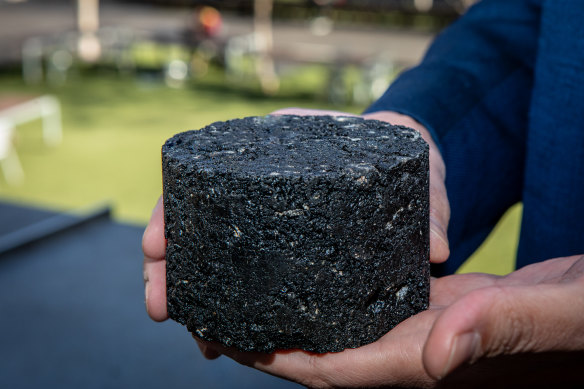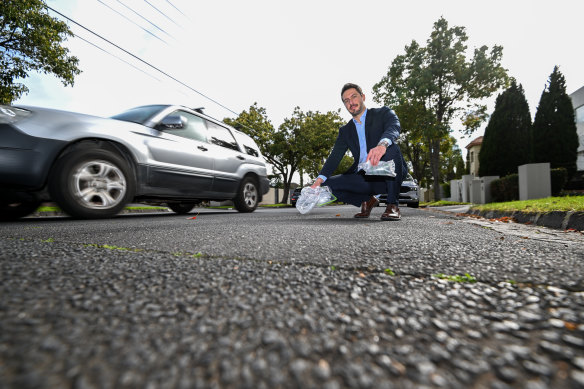Save articles for later
Add articles to your saved list and come back to them any time.
Key points
- Scientists say recycled roads perform better than regular roads, and cost about the same
- But the roll-out seems stuck in the pilot phase, even as other countries embrace the technology
- Issues include regulations, cost, and scepticism from environmentalists
Pete Shmigel is beyond frustrated. The former head of the Australian Council of Recycling has been campaigning for the rollout of recycled roads for more than half a decade now.
But the technology remains largely stuck in the testing phase.
“We have scientific proof. We have validation,” he says. “But we want to stuff around until someone basically completely guarantees this thing will never ever do anything bad – it’s a nonsense.”
A slab of blacktop containing recycled plastics.Credit: RMIT / Supplied
Schmigel is not alone in his frustration. Scientists working on the technology are frustrated too.
But councils remain wary – and environmentalists deeply sceptical.
This week, RMIT University announced a pilot project working with 10 councils to lay test strips of recycled road. The project will use up more than 21,000 kilograms of recycled plastics, which will get melted into the bitumen.
Filippo Giustozzi is a researcher working on using recycled plastics to make roads.This road in Brighton will be resurfaced using a mix that will include recycled plastics. Credit: Joe Armao
But the project will lay less than 10 kilometres of recycled road in total. VicRoads continues to trial recycled materials, including rubber, soft plastics and crushed glass on the Great Ocean Road and other highways.
Meanwhile, India made recycled-plastic roads mandatory near big cities in 2015, and the Netherlands has been installing plastic-only roads that don’t use any bitumen at all.
The hold up: “scepticism”, says Associate Professor Filippo Giustozzi, who leads the project.
His team has been funded by the federal government to test recycled roads’ performance, cost-effectiveness and environmental effects.
In a series of published studies, they showed adding small amounts of recycled plastics actually improves road performance.
“It creates a sort of performance booster for the road itself,” he says.
The road industry already knows this. High-performance bitumen, like the covering on airport runways, already incorporates virgin plastic.
“Every time you have more traffic, or adverse weather conditions, or need to guarantee a longer surface life, or paving a runway – you just go with polymer modified asphalt,” he says.
Combined with hot asphalt and gravel at temperatures close to 180 degrees, the soft plastics melt and form a tight matrix.
But adding plastic to a standard road slightly increases the cost. So far, councils have largely baulked at that extra cost – and the added risk that comes with using a new material.
“We are hugely risk-averse,” fumes Pete Shmigel, who now runs Revolve Recycling, a company that would like to sell recycled rubber for use in roads. “Councils, public authorities, just don’t want to act unless the whole proposition is fundamentally de-risked for them.”
The missing piece of the puzzle is government regulation, says Peter Anderson, CEO of the Victorian Waste Management Association.
If the government were to require a certain level of recycled material in all roads, the industry would scale up and costs would quickly come down.
“It’s one thing to say we can do it. We can get a person on the moon. You have to get all the processes right – and we haven’t had the scale to invest In the processes.”
A second hold-up: fears of microplastic contamination, flying off the road as cars drive over it or leeching silently into the groundwater beneath the blacktop.
In a study published last year, his team demonstrated they produce similar levels of microplastics to existing roads. Is that reason not to use them?
“A lot of the stuff we currently use to make roads is not rose water. It’s the waste out of crude oil,” says RMIT’s Giustozzi.
Environmentalists don’t agree. Not only are we adding extra sources of plastic to the environment, says Jeff Angel, director of the Boomerang Alliance, but “it’s a low-value purpose for collected recycled material”.
“And the aim of a circular economy is to have collected recycled material used for high-value use, again and again.”
Instead, he argues, we should keep our recycled plastics for high-value uses – like recycling back into plastic packaging, that can be used again and again.
Get the day’s breaking news, entertainment ideas and a long read to enjoy. Sign up to receive our Evening Edition newsletter here.
Most Viewed in National
From our partners
Source: Read Full Article




